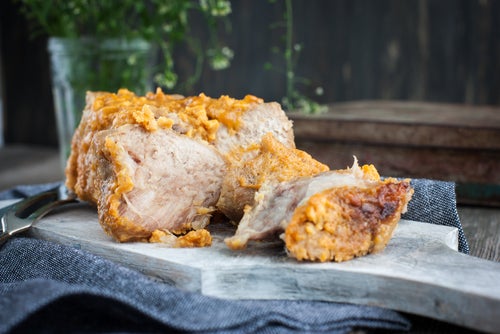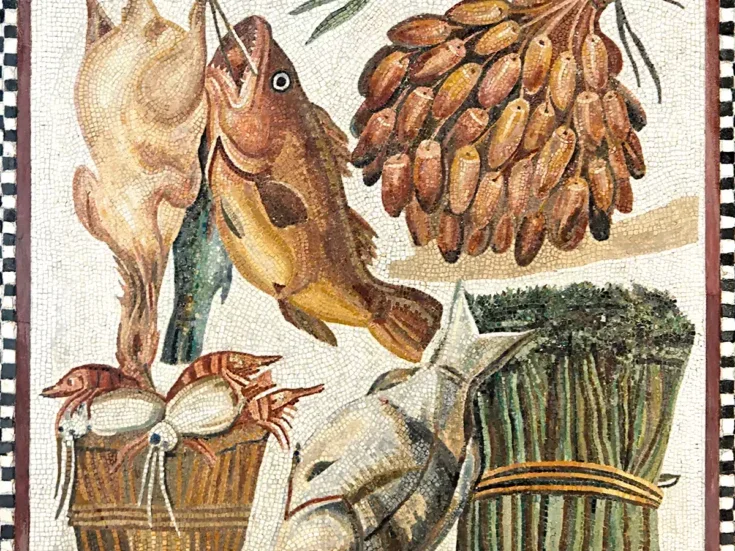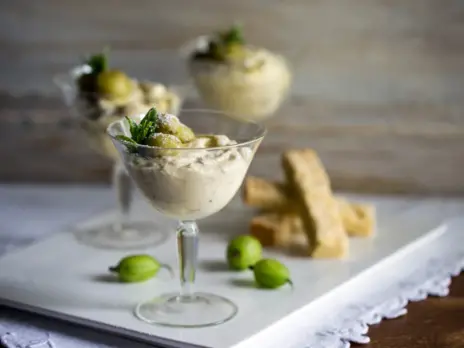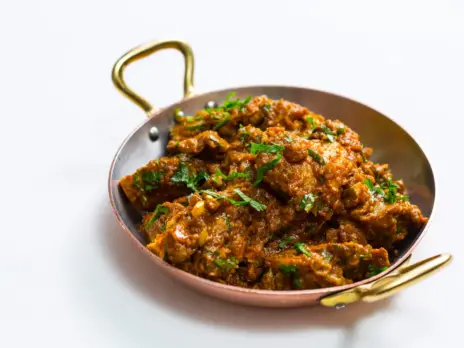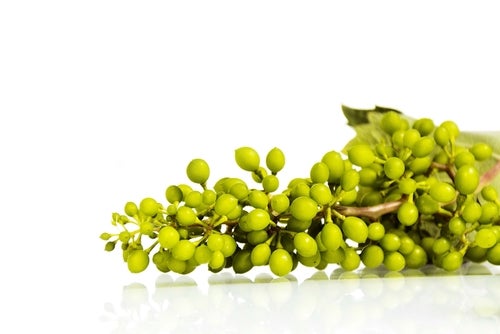
It may sound odd but one of Australia’s culinary gifts to the contemporary world is verjuice, the acidulant made from unripe, unfermented grapes. Or, to be precise, it’s the gift of Australian food personality Maggie Beer—food producer, cookbook author, TV food series co-host, former chef, restaurateur, and grape grower, and AO (officer of the Order of Australia) among other honors.
Odd because verjuice has been around for aeons in Europe, Persia, and the Arab world—in France known as verjus or vert jus, in Italy as agresto, in Spain as agraz, in Persian cooking as ab-ghooreh, and in Lebanon as husroum or hosrum. And it was often valued for its perceived medicinal properties as well as its culinary uses, but no need to go there—food and historical medical treatments can make for a queasy combination.
Acresta, the forerunner of verjuice, is said to be mentioned alongside wine in Roman texts dating back to AD71. I haven’t been able to verify that, but I can quote a few other authorities. Karima Moyer-Nocchi, author of The Eternal Table—A Cultural History of Food in Rome (2019) and a tenured professor at the University of Siena, says on her website that Platina (the 15th-century writer Bartolomeo Platina) quotes the Roman writer Macrobius in the 5th century: “Vinegar is sharper than verjuice, whose force it is agreed is greater than acresta, which soothes the burning of the stomach more mildly, and does not weaken the body as vinegar is apt to do.” Macrobius is quite right: verjuice is milder than vinegar—and, indeed, lemon juice. That’s why it’s such a useful and versatile ingredient, but we’ll come back to that after a bit more historical context and color.
Professor Moyer-Nocchi, who gives a 1549 recipe for fried mushrooms with verjuice from Chrisotforo Messisbugo, a nobleman in the d’Este household in Ferrara and in the Gonzaga court, says that agresto became so common that it came to be used as a metaphor for grumpy, appearing in Florio’s Italian-English Dictionary of 1611. She also cites Giacomo Castelvetro in The Fruits, Herbs, and Vegetables of Italy (1614) saying: “Every family with an acre of land makes at least one barrel of it,” every year.
It was sometimes made with other unripe fruit, such as crab apples or gooseberries, and was a popular ingredient in both savory and sweet dishes in England, too, from the Medieval period onwards: commonplace enough for a character in Thomas Middleton’s play of the 1620s, Women beware Women, to say: “Ay, sir, for having a crabbed face of her own, she’ll eat the less Verjuyce with her mutton.”
Yet after centuries of use, verjuice began to fall out of favour, displaced especially by the introduction and then the cultivation of lemons in Europe. It did still appear in cook books in the latter half of the 20th century (Elizabeth David’s French Provincial Cooking, 1960, Paula Wolfert’s The Cooking of South West France, 1983, and Jeanne Strang’s Goose Fat and Garlic, 1991, to name three on my shelves), but it was homemade.
It was also present in Australia. According to Paringa Estate in Mornington Peninsula, Victoria, which sells a verjuice made from underripe Pinot Noir and Shiraz from its home vineyard, “[Verjuice] has been in our pantries since Colonial days. A recipe from the Adelaide Observer (July 1844), for a medicinal preparation called ‘Black Drop’, requires three pints of verjuice and half a pound of opium! It is also listed as an ingredient in dishes such as ‘Beef A La Mode’ and ‘Calf’s Brains A La Maitre D’Hotel ‘ (The Australasian 1864).”
By the 1970s, I suspect its presence in Australian pantries wasn’t widespread. Certainly, when Maggie Beer comes into the story she doesn’t know about it, but then she was not from a wine region. She and her husband moved to the Barossa Valley from Sydney in 1973 to breed pheasants, buying a vineyard at the same time to provide an income while the pheasants got established. Six years later, they opened The Farmshop to sell their produce prepared and cooked in different ways. Maggie immersed herself in books on food from Mediterranean cultures, first Elizabeth David and then female cooks from rural France. “It was through them that I learnt about verjuice for the first time,” she writes in Maggie’s Verjuice Cookbook (Lantern 2012).
Her verjuice moment came in 1984 when, with a fairly modest vintage in a depressed wine grape market, the Beers couldn’t sell their Riesling grapes. Maggie decided to make verjuice, enlisting the help of a winemaker friend, Peter Wall.
Initially, she gave her verjuice away to chefs she knew and used it herself, before making the jump into commercial production, becoming the first person in the world to do so. Sales were slow at first, but by the turn of the century they were international and, in the meantime, she had started writing cookbooks, the first appearing in 1993 and her first on verjuice in 2001.
You might expect a product made from, in Maggie Beer’s words, “very tart” unfermented grapes would give a big hit of sourness, but, as she writes in Maggie’s Verjuice Cookbook, verjuice is the most gentle of acidulants: “It truly lifts the flavour of food without dominating.” And that means it’s not only versatile as an ingredient across savory and sweet dishes but, crucially, doesn’t deal a sledgehammer to fine wine, especially red wines, in the way that dishes sharply flavoured with lemon or vinegar often do.
The best wines to pair with verjuice and lamb shanks
The recipe I have chosen to illustrate this is Lamb shanks with dried apricots, green peppercorns, and preserved lemon from the 2012 cookbook, which I picked for a few reasons. One is that she says her mother used to roast lamb, probably shoulder, with dried apricots, so it’s a dish with some sort of Australian antecedents (Maggie Beer was born in 1945). Another is that the lamb and dried apricot combination is not unusual, but most recipes are for tagines, or at least Moroccan-inspired, and so are sweeter and spicier. The other is that there are potential challenges for accompanying wines in the sweetness of the fruit, the peppery vibrancy and heat of the green peppercorns in brine (drained), and the salty preserved lemons.
In fact, though, the balance of umami slow-cooked meat, sweet fruit, peppery spice, saltiness, and delicate sharpness from the lemon and verjuice is such that nothing overpowers anything else, making it a wine-friendly dish, especially towards red wine. There are white wines that pair well with lamb dishes, as we said in At the table with the World’s Best Wine Lists: The best wines to pair with lamb and At the table: Kydonato, but this is not one of them. Slow-cooked meat tends to be better with red wine, especially, as here, when red wine is used in the cooking and when acidity isn’t prominent.
This is a dish best accompanied by a red that has the complexity of maturity. The wine that I find pairs particularly well is fine, mature Rioja Reserva. The subtle complexities of mature Gran Reserva can be slightly diminished by the dried apricot, while a good Crianza, again with a little extra bottle age, works, but is a little less successful than a more complex Reserva.
My counsel of perfection is Baron de Ley 7 Viñas Reserva, a complex, rich, and long-lived wine made from a blend of the seven original Rioja grape varieties from a single vineyard that is more than 70 years old. It’s created with four individually tailored vinifications, aged separately for 36 months in different casks before being blended and aged for a further 12 months in French oak foudres. I recently enjoyed an impeccable 2001, but I am not suggesting it needs to be a wine of such age.
Other reds I recommend highly include Grenache-based Southern Rhône-style blends, such as Châteauneuf-du-Pape, Gigondas, and Cairanne and those from the Barossa. Barossa Cabernet Shiraz blends such as Penfolds Bin 389 are also very companionable (I had a 1994 Bin 389 which went very well, but much younger vintages would work). Cabernet Sauvignon alone is less successful, but mature St-Emilion and Graves from good vintages can come into their own. And if the idea of pairing with orange wine appeals to you, aim for one based on an aromatic grape variety that will cosy up to the apricot and one that isn’t very tannic.

